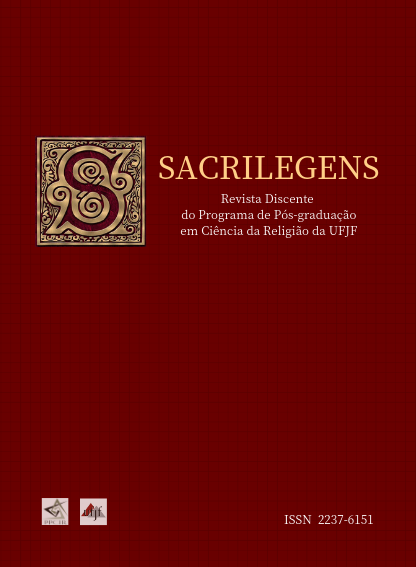Modelos e Moldes de tradições: a hermenêutica do movimento Hare Krishna (ISKCON) sobre a tradição Gaudiya Vaishnava.
Palavras-chave:
tradição, legitimidade, identidade e comunidadeResumo
A tradição Vaishnava tem seu fundamento canônico nos Vedas e por princípio supremo a devoção e o serviço a Visnu-Narayana. Na iconografia religiosa indiana existem diferentes modelos de comunidades organizadas em torno de uma norma que procura estabelecer as bases sobre o que possa ser considerado como um autêntico processo e serviço devocional a Vishnu. Para este texto, a análise terá por objetivo procurar demonstrar como foi construída a norma que legitimou a Gaudiya Vaishnava como um modelo de tradição Vaishnava e, também, se fará a mesma reflexão quanto à norma que consagrou o movimento Hare Krishna (ISKCON), no Ocidente e depois na Índia, como uma tradição estabelecida à parte da Gaudiya Vaisnava. Ou seja, quando o molde acaba se tornando em um modelo de tradição para a sua própria tradição de origem.
Downloads
Referências
Mestrado em Ciências Sociais. Pontifícia Universidade Católica do Rio Grande do Sul. Porto Alegre. 2005.
BOYER, Pascal. Tradition as truth and communication: a cognitive description of traditional discourse. Cambridge University press, 1990
BRZEZINSKI, Jan. Charismatic renewal and institutionalization in the history of Gaudiya Vaishnavism and the Gaudiya Math. In: BRYANT, Edwin F. and Ekstrand,
Maria L. (Org.). The Hare Krishna Movement – The postcharismatic fate of a religious transplant. New York: Columbia University press, 2004.
DE, Sushil Kumar. Early History of the Vaisnava faith and movement in Bengal. Calcutta: General printers and publishers limited, 1942.
GUERRIERO. S. O movimento Hare Krishna no Brasil: a comunidade religiosa de Nova Gokula. Dissertação de mestrado, PUC- SP. 1989.
HANDLER, Richard e LINNEKIN, Jocelyn. Tradition, genuine or spurious. Journal of American Folklore, 97, 1984, pp. 273-290
HOBSBAWM, Eric e RANGER, Terence (eds.) The invention of tradition. Cambridge: Cambridge University press, 1983.
HYMES, Dell. Folklore’s nature and the sun’s myth, Journal of American Folklore, 88 pp. 345-369, 1975.
LÉVI-STRAUSS, C. O pensamento selvagem. São Paulo: CEN, 1962[1976].
MUKHERJEE, S.C. Some Aspects of Chaitanya's contribution to the sócio-religious history of Bengal. In.: BHATTACHARYA. S.C. (Org.) Vaishnavism in Eastern India. Calcutta: Firm KLM Private Limited, 1995.
POLLOCK, Sheldon. “The Sanskrit Cosmopolis, 300-1300: Transculturation, Vernacularization and the Question of Ideology”. In: Ideology and Status of Sanskrit: Contributions to the History of the Sanskrit Language, pp.197-247. Ed. Jan E.M. Houben. Leiden: E.J.Brill, 1996.
KAVIRAJA, Krishna dasa. The Caitanya caritamrta. Trans. Edward C. Dimock, Jr., ed. Tony K. Stewart. Cambridge: Department of Sanskrit and Indian Studies. Harvard University, 1999.
ROCHFORD Jr. Burke. Hare Krishna in America. Rutgers University Press, 1984.
ROSEN, Steven. Who is Shri Chaitanya Mahaprabhu? In: J. EKSTRAND, L.M; E.F. Bryant (Org.) The Hare Krishna Movement – The postcharismatic fate of a religious
transplant. Columbia University Press, 2004.
______, Steven J. Sri Pancha Tattva: The five features of God. New York: Folk Books, 1994
SATSVARUPA, Goswami dasa. Plantando a semente - Nova Iorque 1965-1966: uma biografia de sua Divina Graça A.C. Bhaktivedanta Swami Prabhupada. São Paulo: BBT, 1986.
SHERBOW, Paul H. A.C. Bhaktivedanta Swami’s preaching in the context of Gaudiya Vaishnavism. BRYANT, Edwin F. and Ekstrand, Maria L. (Org.). The Hare Krishna
Movement – The postcharismatic fate of a religious transplant. New York: Columbia University press, 2004.
SILVEIRA. Marcos S. Hari Nama Sankirtana: etnografia de um processo ritual. - Série Antropologia, n. 277, 2000, pp. 24 – 62.
STEWART, Tony K. The final word. The Caitanya Caritamrita and the Grammar of Religious Tradition. Oxford university press, 2010.
VALLVERDÚ, Jaume. El cant de la devoció un estudi antropològic sobre els Hare Krishna. Tarragona. Arola, 2000.
WILLIAMS, Raymond. The long revolution, Nueva York: Columbia University press, 1961.
Downloads
Publicado
Como Citar
Edição
Seção
Licença
 A Revista Sacrilegens é um periódico de acesso aberto, licenciada sob a licença Creative Commons Attribution 4.0 International
A Revista Sacrilegens é um periódico de acesso aberto, licenciada sob a licença Creative Commons Attribution 4.0 International










